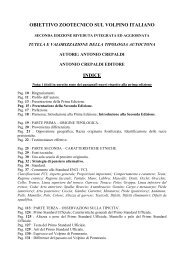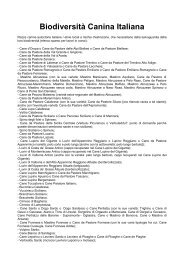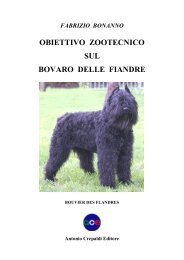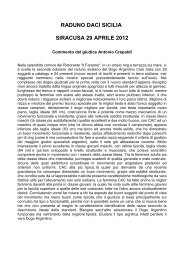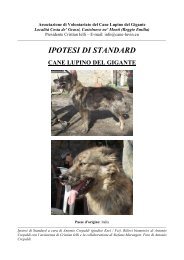standard redatto secondo schema fci 2011 ... - Antonio Crepaldi
standard redatto secondo schema fci 2011 ... - Antonio Crepaldi
standard redatto secondo schema fci 2011 ... - Antonio Crepaldi
You also want an ePaper? Increase the reach of your titles
YUMPU automatically turns print PDFs into web optimized ePapers that Google loves.
FEDERATION CYNOLOGIQUE INTERNATIONALE (FCI) (AISBL)<br />
Place Albert 1er, 13, B – 6530 Thuin (Belgique)<br />
tel: +32.71.59.12.38, fax: + 32.71.59.22.29, internet: http://www.<strong>fci</strong>.be<br />
________________________________________________________________________________<br />
FCI-Standard Nr: 195<br />
VOLPINO ITALIANO<br />
Paese d’origine: Italia
ORIGINE: Italia<br />
DATA DI PUBBLICAZIONE DELLO STANDARD UFFICIALE VIGENTE: 00/00/0000.<br />
UTILIZZAZIONE: Cane da compagnia e da guardia. In passato veniva particolarmente usato per<br />
fare la guardia ai carichi di merci sui carri trainati dai cavalli contro i tentativi di furto lungo i<br />
tragitti.<br />
CLASSIFICAZIONE FCI: Gruppo 5 - Cani di tipo spitz e di tipo primitivo, Sezione 4 - Spitz<br />
Europei; non sottoposto a prova di lavoro.<br />
BREVE RIASSUNTO STORICO: Razza autoctona del territorio italiano testimoniata da<br />
documentazione risalente ad almeno la metà del Secondo Millennio. Il più antico reperto<br />
testimoniale maggiormente conosciuto è infatti il dipinto ad olio su tela del 1502 intitolato “La<br />
visione di Sant’Agostino”, conservato a Venezia alla Scuola di San Giorgio, opera di Vittore<br />
Carpaccio, Grande Maestro della pittura. L’epoca di maggior splendore del Volpino Italiano risale<br />
tra fine Settecento ed inizio Ottocento, quando era molto diffuso nelle regioni della Toscana e del<br />
Lazio, ma anche nelle storiche masserie di tutto il Sud Italia, accanto a Cani Corso, Mastini<br />
Napoletani e Pastori Maremmano-Abruzzesi, come instancabile sentinella d’allarme nelle zone<br />
rurali più sperdute. Entrato nella cinofilia con lo <strong>standard</strong> del 1913, ebbe superbi campioni fino alla<br />
metà dello stesso secolo quando scomparve. Recuperato nella varietà di colore bianco a partire dal<br />
1968, ritornò nei libri genealogici con i primi capostipiti del 1972 che ricostituirono la razza. Con<br />
l’inizio del Terzo Millennio è stata avviata l’azione di recupero e ricostruzione anche della varietà<br />
di colore rosso.<br />
ASPETTO GENERALE: Cane di piccola taglia, ben raccolto, agile e solido, armonico, coperto da<br />
pelo lungo e sollevato.<br />
PROPORZIONI IMPORTANTI: Lunghezza del tronco dalla punta della spalla alla punta della<br />
natica uguale all’altezza al garrese; altezza del torace leggermente inferiore alla metà dell’altezza al<br />
garrese; lunghezza del muso inferiore alla metà della lunghezza totale della testa (lunghezza del<br />
muso inferiore del 13% rispetto alla lunghezza del cranio)-(un volpino italiano alto al garrese 30 cm<br />
deve avere il muso lungo 5 cm [43,5%] ed il cranio lungo 6,5 cm [56,5%] della lunghezza totale<br />
della testa di 11,5 cm).<br />
COMPORTAMENTO/TEMPERAMENTO: Molto attaccato alla casa ed alle persone di<br />
famiglia, è piuttosto vivace ed allegro, con temperamento esuberante.<br />
TESTA: A forma di piramide, la lunghezza totale non raggiunge i 4/10 dell’altezza al garrese.<br />
REGIONE CRANIALE: Cranio di forma alquanto ovoidale, sia in senso sagittale che trasversale;<br />
direzione degli assi cranio-facciali leggermente convergenti; profilo superiore del cranio<br />
leggermente convesso.<br />
Cranio: Larghezza bizigomatica superiore alla metà della lunghezza totale della testa nella misura di<br />
7,3 cm a 11,5 cm (in un volpino italiano alto al garrese 30 cm)-(cranio largo il 63,5% della<br />
lunghezza totale della testa); seni frontali ben sviluppati; sutura metopica pochissimo accentuata;<br />
apofisi occipitale poco marcata.<br />
Stop: Ben accentuato.<br />
________________________________________________________________________________<br />
FCI-St. Nr 195 – 00.00.0000<br />
2
REGIONE FACCIALE<br />
Tartufo: Grande; prosegue il profilo superiore rettilineo della canna nasale e non è sporgente sulla<br />
linea verticale anteriore delle labbra; pigmentazione nera; narici ben aperte.<br />
Muso: Lunghezza inferiore a quella del cranio (in un volpino italiano alto al garrese 30 cm il muso è<br />
lungo 5 cm [43,5% della lunghezza totale della testa] ed il cranio è lungo 6,5 cm [56,5% della<br />
lunghezza totale della testa]); ben profondo; largo alla base con facce laterali convergenti fra loro<br />
ma senza diventare troppo appuntito; canna nasale rettilinea; profilo inferiore del muso dato dal<br />
margine inferiore rettilineo della mandibola.<br />
Labbra: Margine inferiore delle labbra superiori viste di fronte risultano a linea retta;<br />
sufficientemente spesse; aderenti alle mascelle con commessura labiale non visibile; pigmentazione<br />
nera.<br />
Mascelle/Denti: Mascelle robuste; dentatura completa di numero, con denti bianchi di sviluppo<br />
normale; incisivi regolarmente allineati e con chiusura a forbice (tollerata a tenaglia).<br />
Guance: Normalmente sviluppate, perciò non sporgenti.<br />
Occhi: Grandezza normale e ben aperti; apertura rotondeggiante; iride di colore bruno scuro; bulbo<br />
oculare non prominente; posizione sub-frontale; margini palpebrali ben aderenti al bulbo oculare e<br />
con pigmentazione nera; espressione attenta e vivace.<br />
Orecchie: Inserite alte; portate naturalmente erette con faccia interna diretta in avanti, si<br />
posizionano ravvicinate fra loro <strong>secondo</strong> quanto consentito dal cranio più largo che lungo; forma<br />
triangolare; lunghe la metà della lunghezza totale della testa, con base larga e rigida cartilagine ben<br />
spessa.<br />
COLLO: Profilo superiore leggermente convesso; lunghezza quasi uguale alla lunghezza totale<br />
della testa; portato eretto con muscolatura ben sviluppata; pelle ben aderente.<br />
TRONCO: Inserito nel quadrato, per la lunghezza misurata dalla punta della spalla alla punta della<br />
natica uguale all’altezza al garrese.<br />
Linea superiore: Rettilinea nel tratto dorsale e leggermente convessa nel tratto lombare.<br />
Garrese: Leggermente elevato sulla linea dorsale; si congiunge armoniosamente al collo.<br />
Dorso: Rettilineo; muscolatura solida; più lungo dei lombi.<br />
Lombi: Corti; ben larghi; molto muscolosi da renderli leggermente arcuati.<br />
Groppa: Segue la linea dei lombi; inclinata sull’orizzontale a 10° dall’anca all’inserzione della coda<br />
ed a 30° dall’ileo all’ischio; più lunga che larga; ben muscolosa.<br />
Torace: Lungo quasi 4/10 dell’altezza al garrese da rendere la retrostante regione lombare corta;<br />
largo 1/3 dell’altezza al garrese; disceso sino ai gomiti, è leggermente inferiore alla metà<br />
dell’altezza al garrese; costole ben cerchiate; petto proporzionatamente largo, con regione sternale<br />
lunga e manubrio dello sterno non prominente oltre la punta delle spalle.<br />
Linea inferiore e ventre: Linea sternale che sale poco verso il ventre, che perciò è poco rientrante;<br />
fianchi con incavo poco accentuato.<br />
CODA: prosegue la linea della groppa, perciò è inserita alta; si restringe leggermente verso la<br />
punta; lunga poco meno della metà dell’altezza al garrese; ben spessa e robusta; ricoperta<br />
abbondantemente da pelo lunghissimo; portata costantemente sul dorso sia da fermo che in<br />
movimento, con la particolarità che più si avvicina al collo meglio è.<br />
________________________________________________________________________________<br />
FCI-St. Nr 195 – 00.00.0000<br />
3
ARTI<br />
ARTI ANTERIORI<br />
Aspetto generale: Perfettamente in appiombo sia visti di fronte che di lato; altezza al gomito<br />
leggermente superiore alla metà dell’altezza al garrese.<br />
Spalla: Lunga 1/4 dell’altezza al garrese; inclinata a 60° sull’orizzonte; muscolatura ben sviluppata;<br />
angolo scapolo-omerale di 125°.<br />
Braccio: Lungo più della spalla; inclinato a 65° sull’orizzonte; muscolatura ben sviluppata.<br />
Gomito: Parallelo al piano mediano del corpo; angolo omero-radiale di 155°.<br />
Avambraccio: Lungo più del braccio; muscolatura asciutta; ossatura piccola ma robusta.<br />
Carpo: Largo quasi quanto l’avambraccio; ben spesso.<br />
Metacarpo: Largo quasi quanto l’avambraccio; leggermente flesso.<br />
Piedi anteriori: Forma ovale; dita ben arcuate ed unite; unghie preferibilmente pigmentate di nero;<br />
cuscinetti plantari e digitali robusti e pigmentati di nero.<br />
ARTI POSTERIORI<br />
Aspetto generale: Perfettamente in appiombo sia visti di lato che da dietro; non si allungano tanto<br />
dietro al tronco.<br />
Coscia: Lunga 1/3 dell’altezza al garrese; ben larga; muscolatura molto sviluppata; inclinata a 60°<br />
sull’orizzonte; angolo coxo-femorale di 90°.<br />
Ginocchio: Parallelo al piano mediano del corpo; angolo femoro-tibiale di 115°-120°.<br />
Gamba: Lunghezza alquanto inferiore a quella della coscia; inclinata a 55°-60° sull’orizzonte;<br />
muscolatura ben sviluppata; ossatura leggera ma robusta.<br />
Garretto: Più spesso che largo; angolo tibio-tarsico di 145°-150°.<br />
Metatarso: La sua lunghezza è tale da posizionare la punta del garretto ad una distanza da terra<br />
leggermente superiore al 25% dell’altezza al garrese; sufficientemente largo; è verticale e perciò in<br />
perfetto appiombo sia visto di lato che da dietro.<br />
Piedi posteriori: Con tutte le stesse caratteristiche dei piedi anteriori.<br />
ANDATURA/MOVIMENTO: Trotto normale, non saltellante; l’andatura caratteristica è il<br />
galoppo resistente su lunghe distanze, che si riflette in un trotto ordinario, meno allungato rispetto al<br />
movimento di un tipico trottatore.<br />
PELLE: Tesa ed aderente in ogni regione, non è troppo spessa da nascondere le cesellature ossee;<br />
la pigmentazione aumenta con l’età.<br />
MANTELLO<br />
Pelo: Pelo di copertura lunghissimo ed eccezionalmente diritto, che viene mantenuto sollevato dal<br />
folto sottopelo e non “sparato” poiché leggero; la tessitura del pelo di copertura è vitrea, mentre il<br />
sottopelo è lanoso; l’insieme del mantello, anche quando non è molto lungo e folto, è molto spesso<br />
e consistente, preferibilmente senza essere cadente; il pelo avvolge il tronco come un manicotto, in<br />
particolare sul collo dove forma un ampio collare e non una criniera; il cranio è coperto da pelo<br />
semilungo, che nasconde la base delle orecchie, mentre il muso ha pelo corto; l’orecchio è coperto<br />
da pelo molto fine e corto; la coda è guarnita da pelo lunghissimo; sui margini posteriori degli arti il<br />
pelo forma delle frange.<br />
________________________________________________________________________________<br />
FCI-St. Nr 195 – 00.00.0000<br />
4
Colore: a) bianco unicolore, b) rosso unicolore, c) colore champagne, ammesso ma non desiderato;<br />
sono tollerate sulle orecchie sfumature arancio-pallido, che costituiscono comunque difetto; la<br />
tonalità del bianco, favorita dalla tipica tessitura di qualità vitrea, è densa, tipo latte; la tonalità del<br />
rosso è intensa, tipo rosso-cervo; la tonalità champagne non slavata acquista più valore; nella<br />
varietà rossa è accettabile una sfumatura più chiara alle frange delle cosce ed al margine posteriore<br />
della coda, mentre tale sfumatura è invece solo tollerabile sul petto; sempre nella varietà rossa è<br />
tollerabile un po’ di bianco ai piedi e le punte nere su collare e spalle, purché non sia<br />
un’indesiderabile carbonatura; solo in esemplari rossi particolarmente tipici è inoltre tollerabile un<br />
po’ di bianco sul muso e/o sulla punta della coda, che costituisce comunque difetto.<br />
TAGLIA E PESO<br />
Altezza al garrese: Maschi da 27 a 30 cm; femmine da 25 a 28 cm.<br />
Peso: In proporzione all’altezza al garrese.<br />
N.B.: il maschio ha due testicoli apparentemente normali, completamente discesi nello scroto.<br />
DIFETTI: Ogni deviazione dai punti precedenti saranno considerati un difetto e la gravità con cui<br />
il difetto sarà considerato, sarà in esatta proporzione al suo grado ed al suo effetto sulla salute e sul<br />
benessere del cane.<br />
DIFETTI: Tra i difetti lievi in ordine di importanza osservare: testa un po’ più lunga del rapporto<br />
indicato rispetto all’altezza al garrese; cranio un po’ più stretto del rapporto indicato rispetto alla<br />
lunghezza totale della testa; muso un po’ più lungo del rapporto indicato rispetto alla lunghezza del<br />
cranio; assi cranio-facciali paralleli; tartufo sporgente oltre la linea verticale della labbra; tartufo più<br />
chiaro di pigmento, purché siano ben pigmentate di nero le rime palpebrali e labiali; labbra chiare di<br />
pigmento, purché siano ben pigmentati di nero il tartufo e le rime palpebrali; mancanza di un primo<br />
premolare (PM1); chiusura a forbice rovesciata cioè con il margine anteriore degli incisivi superiori<br />
a stretto contatto con il margine posteriore degli incisivi inferiori, purché le mascelle siano di pari<br />
lunghezza, ma solo in esemplari particolarmente tipici; iride di colore bruno un po’ chiaro; orecchie<br />
un po’ più corte della metà della lunghezza totale della testa; pelo non spesso e consistente se però è<br />
lungo; criniera invece che collare; pelo di copertura non molto lungo; sottopelo non molto folto;<br />
pelo di copertura cadente se con sottopelo poco folto; altezza al garrese non oltre 3 cm dai limiti<br />
indicati; costruzione un po’ pesante e grossolana; tronco leggermente allungato, perciò poco fuori<br />
dal quadrato.<br />
DIFETTI GRAVI<br />
In ordine di gravità: testa molto più lunga del rapporto indicato rispetto all’altezza al garrese; cranio<br />
molto più stretto del rapporto indicato rispetto alla lunghezza totale della testa; cranio rotondo da<br />
presentarsi a palla; occhi di forma ovale; occhi con bulbo prominente; stop a 90°; stop troppo<br />
sfuggente; muso molto più lungo del rapporto indicato rispetto alla lunghezza del cranio; muso non<br />
pieno di substrato osseo, leggero; coda un po’ più corta della metà dell’altezza al garrese; coda<br />
portata costantemente pendente fra gli arti posteriori; coda portata alta da non toccare il dorso;<br />
mancanza di due o più denti; prognatismo con i denti incisivi che non si toccano, purché non deturpi<br />
l’aspetto esteriore del muso; orecchie molto più corte della metà della lunghezza totale della testa;<br />
gamba (tibia) molto lunga e molto inclinata; pelo di copertura di tessitura non vitrea; pelo non<br />
spesso e consistente oltre che corto; pelo “sparato” poiché leggero; assenza totale di sottopelo; pelo<br />
di copertura cadente pur se con sottopelo molto folto; colore rosso slavato; balzane agli arti nel<br />
mantello rosso; carbonatura nel mantello rosso; altezza al garrese oltre 3 cm dai limiti indicati;<br />
costruzione molto pesante e grossolana; tronco molto allungato, perciò molto rettangolare; trotto<br />
saltellante.<br />
________________________________________________________________________________<br />
FCI-St. Nr 195 – 00.00.0000<br />
5
DIFETTI DA SQUALIFICA<br />
1. Aggressivo o troppo timido.<br />
2. Ogni cane che presenta chiaramente una morfologia od un comportamento non normale andrà<br />
squalificato.<br />
3. Esemplare non tipico.<br />
4. Difetti che proibiscono di ottenere alcun titolo alle esposizioni: anurismo o brachiurismo tanto<br />
congeniti che artificiali; enognatismo; prognatismo che deturpa l’aspetto esteriore del muso;<br />
orecchie totalmente pendenti; occhio gazzuolo; canna nasale convessa; assi cranio-facciali<br />
divergenti; depigmentazione totale del tartufo e/o dei margini palpebrali (color carne); qualsiasi<br />
colore diverso dal bianco, dal rosso e dallo champagne; macchie di qualsiasi colore su fondo<br />
bianco, su fondo rosso o su fondo champagne; monorchidismo; criptorchidismo; deficiente sviluppo<br />
di uno od entrambi i testicoli; uno od entrambi i testicoli non ben discesi nello scroto.<br />
________________________________________________________________________________<br />
FCI-St. Nr 195 – 00.00.0000<br />
6
FEDERATION CYNOLOGIQUE INTERNATIONALE (FCI) (AISBL)<br />
Place Albert 1er, 13, B – 6530 Thuin (Belgique)<br />
tel: +32.71.59.12.38, fax: + 32.71.59.22.29, internet: http://www.<strong>fci</strong>.be<br />
________________________________________________________________________________<br />
00.00.000/EN<br />
FCI-Standard Nr: 195<br />
ITALIAN VOLPINO<br />
(Volpino Italiano)<br />
TRANSLATION: Mr <strong>Antonio</strong> <strong>Crepaldi</strong> for ATAVI [Italian Volpino Lovers Technical<br />
Association] (English)<br />
Country of origin: Italy<br />
7
ORIGIN: Italy<br />
DATE OF PUBBLICATION OF THE OFFICIAL VALID STANDARD: 00/00/0000.<br />
UTILIZATION: Guard and companion dog. In the past was particularly utilized as guard dog to<br />
the load of goods on cart to draft of horses against the attempts of theft along the way.<br />
FCI-CLASSIFICATION: Group 5 – Dogs of spitz type and primitive type, Section 4 – European<br />
Spitz; without working trial.<br />
BRIEF HISTORICAL SUMMARY: Autochthnous breed of Italian territory with testimony from<br />
documentation at least since the half of Second Millennium. The more ancient witnesses evidence<br />
more well-known in fact is the oil-painting of 1502 by title “The vision of St. Austin”, preserved in<br />
Venice in St. George’s School, work by Vittore Carpaccio, Big Master of painting. The epoch of<br />
greater splendour of the Italian Volpino was between the end of 18 th Century and first 19 th Century,<br />
when was very diffused in the regions of Tuscany and Latium, but also in the historical farm of all<br />
the South Italy, next to Corso Dogs, Neapolitan Mastiffs and Maremma and Abruzzes Sheepdogs,<br />
as indefatigable sentry of alarm in the more secluded rural areas. In cynophilie with the <strong>standard</strong> of<br />
1913, with haughty champions till the half of same century when is disappeared. With the recover<br />
of the white colour variety to start since 1968, is returned in the genealogical register with the first<br />
founder of a family of 1972 that have reconstituted the breed. With the beginning of the Third<br />
Millennium was under way the action of recover and reconstruction also of the red colour variety.<br />
GENERAL APPEARANCE: Small size dog, well compact, agile and solid, harmonious, with a<br />
long stand-off coat.<br />
IMPORTANT PROPORTIONS: Length of body from the point of the shoulder to point of the<br />
buttock is equal to height at the withers; height of chest is lightly inferior to half of height at the<br />
withers; length of muzzle is inferior to half of total length of the head (length of muzzle is inferior<br />
of 13% respect to length of the skull)-(a Italian volpino with height at the withers of 30 cm to have<br />
the length of muzzle of 5 cm [43,5%] and the length of the skull of 6,5 cm [56,5%] of total length of<br />
the head of 11,5 cm).<br />
BEHAVIOUR/TEMPERAMENT: Very attached to his home and his persons of family, is very<br />
lively and gay, with exuberant temperament.<br />
HEAD: Pyramid shape; total length is not neither the 4/10 of height at the withers.<br />
CRANIAL REGION: Skull of some egg-shaped, whether in longitudinal as transversal diameter;<br />
lightly convergent the direction of cranial-facial axes; superior profile of the skull have is lightly<br />
convex from don’t appear round to ball.<br />
Skull: Bizygomatic width is superior to half of total lenght of the head in the measure of 7,3 cm to<br />
11,5 cm (a Italian volpino with eight at the withers of 30 cm)-(length of the skull is 63,5% of total<br />
length of the head); bony protuberances of forehead are well developed; medio-frontal furrow is<br />
very lightly marked; occipital protuberance is lightly marked.<br />
Stop: Well marked.<br />
________________________________________________________________________________<br />
FCI-St. Nr 195 – 00/00/0000<br />
8
FACIAL REGION<br />
Nose: Great; it is the continuation of rectilinear superior profile of the muzzle and it is not<br />
protruding on the foreface vertical profile of the lips; black pigmentation; well opened nostrils.<br />
Muzzle: Length inferior to length of the skull (a Italian volpino with height at the withers of 30 cm<br />
the length of muzzle is 5 cm [43,5% of total length of the head] and the length of skull is 6,5 cm<br />
[56,5% of total length of the head]; well deep; wide at base with convergent lateral faces between<br />
their but without become very pointed; superior profile is rectilinear; inferior profile of the muzzle<br />
is supplied from the rectilinear inferior border of the jaw.<br />
Lips: Inferior profile of the superior lips seen of front is rectilinear; sufficiently of thick; are closefitting<br />
at the jaw with the labial commissure that is not visible; black pigmentation.<br />
Jaw/Teeth: Strong jaw; set of teeth is complete of number, with white teeth of normal development;<br />
incisors have a regular alignment and are with scissor bite (the pincer bite is tolerated).<br />
Cheeks: Normally development, so not protruding.<br />
Eyes: Normal size and well opened; roundish aperture; iris of dark brown colour; eyeball not<br />
prominent; sub-frontal position; eyelid rims well close-fitting to eyeball and with black<br />
pigmentation; lively and carefull look.<br />
Ears: Are high attached; with naturally erect gait, with forward the internal face, are near between<br />
their for how consent the skull more wide that length; triangular shape; their length is half of total<br />
length of the head, with wide base and a rigid cartilage of good thick.<br />
NECK: Lightly convex the superior profile; length almost equal to total length of the head; erect<br />
gait with well development musculature; well close-fitting skin.<br />
BODY: Square built, for its length measured from the point of the shoulder to the point of the<br />
buttock equal to height at the withers.<br />
Top line: Rectilinear in the dorsal stretch and lightly convex in the lumbar stretch.<br />
Withers: Lightly elevated on the dorsal line; it is harmonically connected at the neck.<br />
Back: Rectilinear; strong musculature; more long that the loin.<br />
Loin: Short; well wide; very muscular from do it lightly arched.<br />
Croup: It follow the line of the loin; inclined on the horizon of 10° from the hip to insertion of the<br />
tail and of 30° from the ilium to the ischium; more long that wide; well muscular.<br />
Chest: It length is almost 4/10 of height at the withers from do short at the back lumbar region; wide<br />
1/3 of the height at the withers; descending to level of elbows, it is lightly inferior to half of height<br />
at the withers; ribs well sprung; breast proportionately wide, with long sternal region and sternal<br />
handle not prominent further the point of the shoulders.<br />
Underline and belly: Sternal line that to go up little towards the belly, that so is little hollow; flanks<br />
with hollow little marked.<br />
TAIL: It follow the line of the croup, so is with high insertion; it is lightly narrow towards the<br />
point; it length is little less of half of height at the withers; well of thick and strong; with abundant<br />
very long hair; with gait always on back whether from stand as during the movement, with the<br />
particularity that more is near at the neck is better.<br />
________________________________________________________________________________<br />
FCI-St. Nr 195 – 00/00/0000<br />
9
LIMBS<br />
FOREQUARTERS<br />
General appearance: Their direction is perfectly straight in plumb seen from the front and from the<br />
side; height at elbow lightly superior to half of height at the withers.<br />
Shoulder: It length is 1/4 of the height at the withers; inclined of 60° on the horizon; well<br />
development muscolature; scapula-humerus angle of 125°.<br />
Upper arm: More long of the shoulder; inclined of 65° on the horizon; well development<br />
musculature.<br />
Elbow: Parallel to the median plane of the body; humerus-radial angle of 155°.<br />
Forearm: More long of the upper arm; dry musculature; small but strong bone.<br />
Carpus (Wrist): Wide almost as the forearm; good thick.<br />
Metacarpus (Pastern): Wide almost as the forearm; lightly flex.<br />
Forefeet: Oval shaped; joined together and well arched toes; nails preferably with black<br />
pigmentation; strong pads with black pigmentation.<br />
HINDQUARTERS<br />
General appearance: Their direction is perfectly straight in plumb seen from the side and from the<br />
rear; their are not very oblong rear the body.<br />
Thigh: Its length is 1/3 of height at the withers; well wide; very development musculature; inclined<br />
of 60° on the horizon; coxo-femoral angle of 90°.<br />
Stifle (Knee): Parallel to the median plane of the body; femoro-tibial angle of 115°-120°.<br />
Lower thigh: Its length is some inferior that the thigh; inclined of 55°-60° on the horizon; well<br />
development musculature; light but strong bone.<br />
Hock joint: More of thick that wide; tibio-tarsal angle of 145°-150°.<br />
Metatarsu (Rear pastern): Its length is such from place the point of the hock joint to a distance from<br />
earth lightly superior of 25% of height at the withers; sufficiently wide; it is vertical and so with<br />
direction in perfect plumb seen from the side and from the rear.<br />
Hind feet: With alls the same characteristics of the forefeet.<br />
GAIT/MOVEMENT: Normal trot, not jumpy; the characteristic gait is the resistant gallop on long<br />
distance (stayer and not sprinter), that produce a normal trot, less oblong respect at the movement of<br />
a typical trotter.<br />
SKIN: Taut and close-fitting in alls the regions, it is not very of thick from hide the bone chisels;<br />
the pigmentation increase with the age.<br />
COAT<br />
Hair: Overcoat is very long and exceptionally straight, that is maintained raised from the very much<br />
undercoat and not as a “volley” as light; the texture of the overcoat is vitreous, while the undercoat<br />
is woolly; the whole of the coat, also when is not very long and abundant, it is very substantial and<br />
of thick, preferably without be falling; the hair wind the body as a muff, specially on the neck where<br />
form a broad collar and not a mane; the skull is covered from semi-long hair, that hide the base of<br />
the ears, while the muzzle have shorthair; the ear is covered from very fine and shorthair; the tail is<br />
covered from very much longhair; on the back regions of the limbs the hair form of the bangs.<br />
________________________________________________________________________________<br />
FCI-St. Nr 195 – 00/00/0000<br />
10
Colour: a) uni-colour white, b) uni-colour red, c) colour champagne, that is accepted but not<br />
desirable; pale-orange shades on the ears are tolerated but in any case constitute a fault; the tonality<br />
of the white colour, favouring from the typical texture of vitreous quality, is dense, as milk type; the<br />
tonality of the red colour is everywhere intense, as deer-red type; the champagne tonality not<br />
washed out to be more of value; in the red colour variety is acceptable a shade more light in the<br />
bangs of the thigh and in the back profile of the tail, while this shade is instead only tolerable on the<br />
breast; always in the red colour variety is tolerable a little white on the feet and the black points on<br />
collar and shoulders, if so is not a undesirable carbonate; only for particularly typical red colour<br />
specimens is besides tolerable a little of white on feet and/or point of the tail, but in any case<br />
constitute a fault.<br />
SIZE AND WEIGHT<br />
Height at the withers: Males from 27 to 30 cm; females from 25 to 28 cm.<br />
Weight: With proportion to height at the withers.<br />
N.B.: Male animals should have two apparently normal testicles fully descended into the scrotum.<br />
FAULTS: Any departure from the foregoing points should be considered a fault and the<br />
seriousness with which the fault should be regarded should be in exact proportion to its degree and<br />
its effect upon the health and welfare of the dog.<br />
FAULTS: Between the light faults with order of importance observe: head a little more long of the<br />
ratio indicated respect to height at the withers; skull a little more narrow of the ratio indicated<br />
respect to total length of the head; muzzle a little more long of the ratio indicated respect to length<br />
of the skull; parallel cranial-facial axes; protruding nose further the vertical profile of the lips; nose<br />
more light of pigment, if so with good black pigment of the palpebral and labial rims; rims light of<br />
pigment, if so with good black pigment of the nose and palpebral rims; lack of a first premolar<br />
(PM1); overturn scissor bite i.e. with foreface of superior incisors to narrow contact with back face<br />
of inferior incisors, if so with the jaws of equal length, but only for particularly typical specimens;<br />
iris of brown colour a little light; ears a little more short of half of total length of the head; coat not<br />
thick and substantial, if so it is long; mane instead that collar; overcoat not very long; undercoat not<br />
very close-fitting; falling overcoat, if so with undercoat little close-fitting; height at the withers not<br />
further 3 cm from indicated limits; built a little heavy and coarse; body lightly oblong, so little out<br />
from square.<br />
SEVERE FAULTS<br />
With order of gravity: head very much long of the ratio indicated respect to height at the withers;<br />
skull very much narrow respect to total length of the head; skull round as a ball; eyes of oval shape;<br />
prominent eyeball; stop of 90°; stop very much elusive; muzzle very much long of the ratio<br />
indicated respect to length of the skull; muzzle not full of bone sub-stratum but light; tail a little<br />
more short of half to height at the withers; tail always tucked in between hindlegs; tail high from<br />
don’t touch the back; lack of two or more teeth; undershot mouth with the incisors teeth without<br />
contact between their, if so don’t disfigure the appearance of the muzzle; ears very much short of<br />
half of total length of the head; lower thigh (tibia) very long and very inclinated; overcoat of texture<br />
not vitreous; coat not thick and substantial further that short; coat as a “volley” as light; total<br />
absence of undercoat; falling overcoat also if with very much undercoat; washed out red colour;<br />
white-footed in the red colour variety; carbonate red colour variety; height at the withers further 3<br />
cm from indicated limits; built very heavy and coarse; body very oblong, so very rectangular;<br />
jumpy trot.<br />
________________________________________________________________________________<br />
FCI-St. Nr 195 – 00/00/0000<br />
11
DISQUALIFYING FAULTS<br />
1. Aggressive or overly shy.<br />
2. Any dog clearly showing physical or behavioural abnormalities shall be disqualified.<br />
3. Untypical specimen.<br />
4. Faults which prohibit a dog from winning any award at dog shows: total or partial lack of tail,<br />
congenital or artificial; overshot mouth; undershot mouth that disfigure the appearance of the<br />
muzzle; ears totally falling; wall eye; convex topline of the muzzle; divergent cranial-facial axes;<br />
total depigmentation of nose and/or eyelid rims (flesh colour); all colours than white, red and<br />
champagne; markings of any colour on white background, on red background or on champagne<br />
background; without one testicle; without two testicles; deficient development of one or two<br />
testicles; one or two testicles not well descents into scrotum.<br />
________________________________________________________________________________<br />
FCI-St. Nr 195 – 00/00/0000<br />
12



